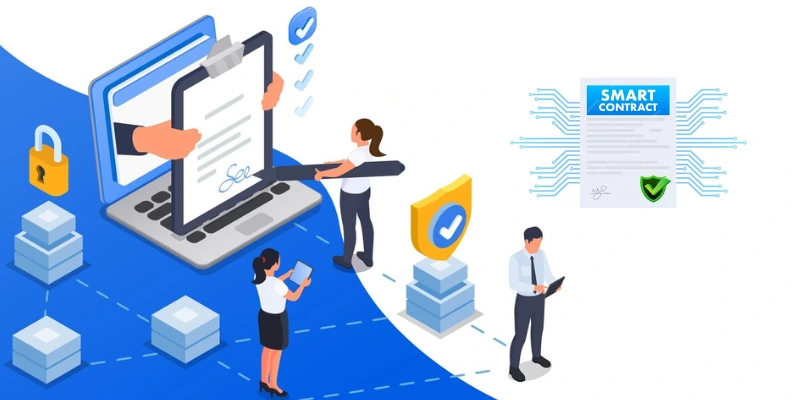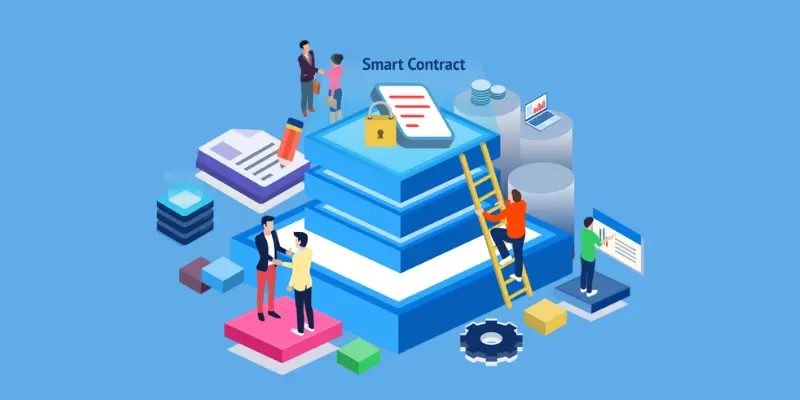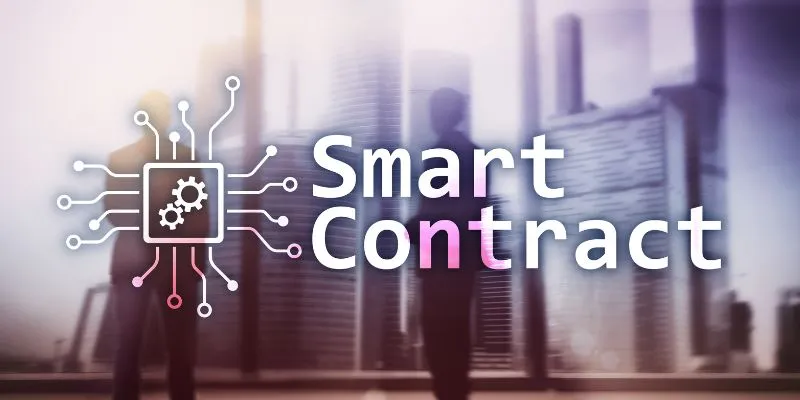Ethereum's introduction of smart contracts revolutionized the Web3 market, empowering developers to develop applications using blockchain-based protocols. Ethereum has established itself as the most popular technology for creating smart contracts; however, there are competitors to the position of the smart contract king.
Smart contracts are proven to be a ground-breaking breakthrough in the field of blockchain. From balancing the holding account to sending transactions and overseeing them, smart contracts have become an integral part of blockchain-based applications created through our blockchain app development services.
Digital contracts work as they are programmed. In addition, they cannot be controlled by users. Smart contracts are based on Blockchain networks. The most widely used blockchain platforms for smart contract design is Ethereum. It's fascinating to witness how effortlessly smart contracts function on Ethereum, but there are also a few problems.
The Ethereum smart contract developers continue adding new features to improve the network's performance. These enhancements affect the functionality of smart contracts available on the platform.
What are Smart Contracts?
Smart contracts are the most important element of blockchain technology. They provide security and an excellent trading platform. Smart contract use instances are expanding across various industries to gain security through mutual agreements.
Smart contracts are an alternative to Ethereum accounts that store a user's balance and transactional data in the Ethereum network and allow users to link their accounts to them.
Smart contracts remove intermediaries, leading to smooth agreements and even transactions. They've become an important part of the app ecosystem.
Key Statistics
-
-
The market for blockchain technology in the world's size was estimated to be $17.46 billion in 2023.
-
Blockchain technology, a global Internet of Things marketplace, is predicted to reach $20,938.59 million by 2032.
-
The global market for healthcare smart contracts size is predicted to reach $7.83 billion by 2030.
-
What Makes Ethereum Smart Contracts Stand Out?
Yes, smart contracts can keep money and even perform transactions on the Ethereum network. However, what makes them distinct is that they are not controlled by one person or any user.
Instead, they're pushed onto the network and work dependent on their program. For the end users, they can participate in the contracts by making transactions that are compatible with the contract's list of functions.
What are Ethereum Smart Contracts?
Ethereum smart contracts are similar to regular smart contracts. Ethereum smart contracts aren't unlike regular smart contracts. In this instance, the smart contracts function as an Ethereum account, which stores the balance of transactions and transfers them over the Internet. In addition, the most effective methods in Ethereum smart contracts also focus on the fact that they must be linked to a network rather than remaining under the user's control.
Ethereum smart contracts operate according to the program, and users can make transactions using the functions of a smart contract they want to use. Smart contracts can assist in creating rules and enforcement of the rules. Furthermore, you should not forget that the transactions made with smart contracts are unchangeable. However, it is a challenge for blockchain systems such as Ethereum, which are constantly changing by introducing best practices.
Components of Ethereum Smart Contracts
Ethereum Virtual Machine
Ethereum Virtual Machine (EVM) is a program that executes smart contracts and calculates the Ethereum network's status after each block is added to the chain. The EVM processes and executes codes written in Ethereum's natural programming languages (e.g., Solidity and Serpent) that compile into bytecode EVM.
EVM plays a key function in developing decentralized apps for financial decentralization (DeFi) along with NFTs, or non-fungible tokens (NFTs), that facilitate quick, reliable, and secure performance of smart contracts.
Solidity
Solidity is a statically typed high-level programming language similar to JavaScript. Because of its simplicity and ease of reading, it is commonly utilized to write smart contracts using EVM. Solidity compiles into EVM bytes and can be developed using Remix or a different IDE.
The various components and features of Solidity help to facilitate secure and efficient intelligent contract design. The language is extremely flexible for testing and debugging because of the integrated log assertions and other features that aid in bug prevention.
Gas
Gas is the price of computing resources required for executing a smart contract or transaction. Each operation requires a specific amount of gas, which is financed with Ether (ETH).
The price of gas is based on the computation complexity and the processing speed. The user and miners determine the price and generally prefer transactions with higher gas prices. Every smart contract comes with its gas limit, which is unique to each smart contract, which defines the amount of gas that can be used per block before deciding not to complete an operation due to lack of funds.
The EVM's gas system serves two main objectives. First, it prevents misuse of the network and ensures equitable and efficient resource allocation by imposing a cost on resource use. In addition, it encourages miners and nodes to handle transactions by providing gas transaction charges.
Steps to Ensure the Security of Ethereum Smart Contracts
If you're interested in the possibilities of Ethereum smart contracts planning and development, you're in the right spot. We're all aware that vulnerabilities and bugs are not something you'd like to see. Let's review some of the principles that will assist you in creating solid and secure contracts.
Be Prepared for the Unexpected
The world is not predictable, and mistakes are bound to happen. However, the secret is how you deal with unexpected challenges. You must stop the contract immediately when you notice something that isn't correct.
Always have a plan to correct and improve any ambiguities. It is also vital to handle the money at hand responsibly. This establishes limits for usage and keeps track of the total amount.
Roll Out Thoughtfully
Instead of jumping headfirst into the water, it is advisable to evaluate the surroundings. This requires thorough testing of your contracts. When you introduce your contract, introduce it gradually, progressively increasing its use and the checks it comes with at each step.
In addition, it's advantageous to reward users who spot issues earlier. It is important to consider rewarding bugs discovered even in the early testing phases. As with each new threat, make sure you incorporate an appropriate test.
Keep it Clean and Simple
Keep in mind that complexity doesn't necessarily equal superiority. In many cases, it opens the way to more errors. Therefore, it is recommended that you focus on simple and clear contract logic. To guarantee reliability, use tried-and-tested codes or tools from prior projects. Additionally, you can decompose the code into smaller, accessible functions. Use blockchain only when you need decentralization. Always prioritize clarity over speed.
Stay in the Loop
The world of digital is always fluctuating. To keep your edge, it's essential to constantly examine your contracts for emerging problems. So, be open to the latest security strategies and update libraries or tools immediately after newer versions become available.
Understand Blockchain Nuances
Even the most seasoned developers could fail when they're not aware of the specifics of blockchain. Be wary of contract calls from outside. Calls, since they could contain malicious code that can interfere with your business.
It's also important to understand that smart contracts have no absolute privacy. What you may consider "private" is visible to other people, and public functions are available to everyone, even potential adversaries.
The blockchain's time isn't always absolute, however. Miners can make minor adjustments each time a transaction occurs. Also, take note of the gas limitations and costs and the fact that creating random numbers on blockchain has an array of challenges.
Also Read: How Much Does It Cost to Develop a Smart Contract
Balance Your Trade-offs
All coins have two sides. While software may suggest one thing, security can be different, but security can suggest another. Let's look at the various dichotomies that exist:
-
-
Duplication in comparison to. Reuse
-
Although it's tempting for companies to reuse the same contract code often, it's more beneficial to duplicate the codes, particularly if the contracts from before aren't easily accessible.
-
-
Monolithic Vs. Modular
-
Monolithic contracts have everything in one spot. It's fantastic, but only when it gets too complicated. If you're working on complex contract systems, consider modular.
-
-
Rigid Vs. Flexible
-
It's a delicate balance between your contract's security and its adaptability. If your contract offers only a few features and a fixed time frame, simplicity should be your primary goal.
Best Practices to Create Ethereum Smart Contract
If you're looking to explore the realm of Ethereum, Solidity is the language you'll be encountering. It's the core of Ethereum Smart Contracts. We'll review some of the best methods to ensure that your contracts function without issue.
Documentation and Procedures
Documenting your processes and work through documentation is vital and allows you to launch your smart contract smoothly. Documentation that includes precise descriptions, diagrams, models, and other details helps users and reviewers better understand the system's capabilities and capability.
Smart Contract best practices include monitoring the progress of code deployment using live performance reports. Additionally, documentation assists users in recognizing the weaknesses, bugs, or threats they can tackle to enhance the quality of their products.
Another reason to use documents is that they will improve users' experience using methods, which can help avoid confusion in the future about the use of the product. For instance, documentation like "What to do" instructions can be helpful when faced with situations that involve bug discovery, emergencies, or any other problems.
Furthermore, product documentation is crucial because it contains the contact details of authorities, developers, or other key people to discuss product-related issues or for any further inquiries.
QA Check Best Practices
Utilize the static analysis tool to identify design inconsistencies and assist in identifying code errors and vulnerabilities that the compiler may overlook. Testing QA cycles to ensure the most effective practices allows you to detect bugs and errors. Make use of a test framework that will enable you to interrupt tests to identify the cause of the flow and confirm the validity of your agreement.
Furthermore, high test coverage measures the effectiveness of your testing and smart contract development. It is possible to have tests with coverage levels that are inadequate or have undiscovered bugs (almost none) and reverse. A different aspect of testing involves security audits, which help identify the unknowns as well as the knowns by using manual audits to verify security.
Smart Contracts are the gateway for digital transactions, and, in contrast to other payment gateways, they provide more security and stability. This is why you should dig deep into the codebase to find security requirements. For this, employ open-source static analysis tools such as Ethersplay, which allows match-up of source code, recovery method, binary diffing, and dynamic leap calculation.
Smart Contracts Security Best Practices
Let your users and the Ethereum community initiate bug bounty programs that can help them identify real-time, missing critical flaws in the Ethereum protocol.
Create smart contracts with code by identifying security weaknesses and analyzing design patterns, which may include access restrictions, secure Ether transferability, emergency stops, check-effect interaction, and much more.
A tragic incident happened in June 2016 in which a hacker discovered an unintended loophole or security flaw in the code that opened an opportunity for the hacker to take 3.6 METH for about $70 million at the time. At present, authorities should be vigilant in the rapidly growing DeFi market, worth close to $1 billion.
Blockchain technology's applications have also been enhanced due to its security and scaling. In the end, many thousands of dApps in different industries, including media, gaming and finance, real estate, and the legal sector, all use smart contracts or plan to use them soon.
DeFi dApps and smart contracts have helped ease the barriers for those entering the finance world by offering loans, trading, borrowing, and other digital opportunities for financial transactions. Additionally, smart contracts can be used in games that use blockchain technology designed with the play-to-earn system.
Blockchain-enabled games and smart contracts allow you to buy or sell NFTs and assets in-game with other players by agreement, which makes the transaction smooth and ensures that you have verified ownership.
Development Best Practices
Smart contracts have brought substantial value to the tech industry and finance by providing safe electronic transaction services. Since the terms of smart contracts are implemented via a blockchain, developers can create smart contracts in different languages while using the best practices for smart contract development services to ensure security and reliability with P2P services.
Developers who are brand new to smart contract development need to adhere to the most effective methods for writing smart contracts, which can be accomplished by leveraging a smart environment for contract development. One such example is Truffle. The use of a development environment speeds up routine tasks such as compilation launches, upgrading, and contract testing for unit tests.
Utilize Security analysis software to find weaknesses or problems related to smart contracts before deployment. It is recommended that this step be taken ASAP because it can be difficult or nearly impossible to update the smart contract in its current state. It is possible to use pre-commit hooks to improve developers' user experience. In addition, failure to secure smart contracts could cause a massive financial crisis.
Furthermore, Ethereum transactions cost money and can take a long time to confirm transactions. It is therefore recommended to use local blockchain that help speed up the development process and lets you manage your contracts while enjoying fast and immediate transactions.
The Key Takeaway
Blockchain technology is now the fastest-growing technology that has facilitated the NFTs development and P2E games, financial decentralization (DeFi) apps, and many more thanks to its numerous advantages for the future.
Additionally, AI-powered smart contracts can be created by combining AI data-intensive processing with secure and unchangeable blockchain technology. However, AI-powered smart contracts are highly complex.
Experts believe that combining AI with smart contracts may increase computational power and provide high security for sharing and storing private machine learning data online.











Share this blog